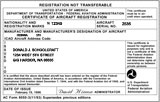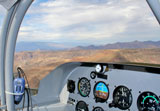|
Experimental LSA Certification ProceduresAs part of the experimental LSA certification process, a general airworthiness inspection of the aircraft will be performed by the FAA/DAR. This inspection will be accomplished after the aircraft is completed and before the issuance of an experimental certificate. During the inspection, the FAA/DAR usually won't request disassembly of the aircraft. The only time disassembly would be requested is when there is a question of safety as a result of the inspection. The applicant must provide documented evidence that the aircraft has been manufactured and constructed to the applicable consensus standard, except when the aircraft is eligible in accordance with FAR 21.191(i)(1). The FAA will review the applicant’s documentation supplied with the aircraft to verify it agrees with the identification and description given in the applicable consensus standard, meets the definition for certification and the requirements of FAR 21.191 or FAR 21.193 as applicable. RECORD INSPECTION AND DOCUMENT REVIEW The FAA will - - Obtain from the applicant a properly executed Form 8130-6 and any other documents required for the certification. Kits and aircraft assembled from kits manufactured outside the United States require evidence of manufacture within countries that have a Bilateral Airworthiness Agreement (BAA) concerning airplanes or a Bilateral Aviation Safety Agreement (BASA) with associated Implementation Procedures for Airworthiness (IPA) concerning airplanes, or an equivalent airworthiness agreement in accordance with FAR 21.193(e)(6). - Obtain from the applicant a program letter identifying the aircraft, the purpose of the experimental LSA certification, the area over which the operations are to be conducted with drawings or photographs, and the duration of the program. - Review documentation for LSA being certificated under FAR 21.191(i)(2). A Statement of Compliance, Form 8130-15, is required. - Review the documentation provided by the applicant to determine that the registration requirements of FAR 47 have been met, and ensure the aircraft is marked in accordance with FAR 45. - Review the aircraft records to determine whether any required maintenance and inspections have been accomplished and to determine that all relevant and applicable ADs and service directives have been complied with. Records must be complete. - Review the applicant’s weight and balance for accuracy and currency for the aircraft submitted. AIRCRAFT INSPECTION The FAA will arrange with the applicant to make the aircraft available for inspection to determine the following: - The ID plate meets the requirements of FAR 45.11, as applicable. - The information on the ID plate is correct, matches the information on Form 8130-6, and isin accordance with FAR 45.13, as applicable. - The aircraft nationality and registration marks are in accordance with FAR 45. - The flight control systems and associated instruments as equipped operate properly and areappropriate for each of the six classes of LSA. - The cockpit instruments are appropriately marked, and needed placards are installedand placed for easy reference. - System controls (for example, fuel selector(s) and electrical switches/breakers) areappropriately placed, clearly marked, provide easy access and operation, and function in accordancewith the manufacturer’s specifications and applicable consensus standard. - An ELT is installed, when required by FAR 91.207. - Airframe emergency parachutes are properly marked and identified. CERTIFICATE ISSUANCE Upon satisfactory completion of the records inspection, documentation review, and aircraft inspection, the FAA will complete experimental LSA certification by issuing a special airworthiness certificate for the purpose of operating an experimental LSA with appropriate operating limitations. The operating limitations will be attached to Form 8130-7. The FAA will review the operating limitations with the applicant to ensure a clear understanding. The FAA may elect to issue an experimental LSA airworthiness certificate on a one-time basis to determine that the aircraft meets the requirements of FAR 91.319(b). When the experimental LSA certification is to be issued for an unlimited duration, the operating limitations may be prescribed in two phases in the same document as follows: - For the phase I limitations, the FAA will prescribe all operating limitations appropriate for the applicant to demonstrate compliance with FAR 91.319(b) in the assigned flight test area. This includes a limitation requiring the owner/operator to endorse the aircraft logbook with a statement certifying that the prescribed flight hours have been completed, and the aircraft has been shown to comply with FAR 91.319(b) and the requirements of the applicable consensus standard. The owner/operator may then operate in accordance with phase II. - For the phase II limitations, the FAA may prescribe operating limitations for experimental LSA for an unlimited duration, as appropriate. - Under FAR 91.319(e), the FAA may prescribe any additional limitations in phase I or phase II deemed necessary in the interest of safety. - If the aircraft meets the requirements of the experimental LSA certification, the FAA will make an aircraft logbook entry and issue the special airworthiness certificate (Form 8130-7) with operating limitations. - If the aircraft does not meet the requirements of the experimental LSA certification requested and the airworthiness certificate is denied, the FAA will write a letter to the applicant stating the reason(s) for denying the airworthiness certificate.
Go from this Experimental LSA Certification Page back to the LSA General Information Page |









